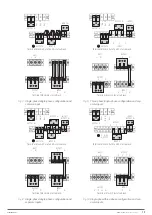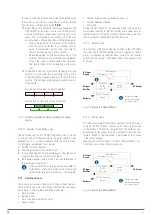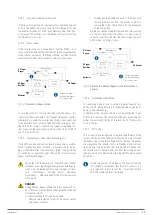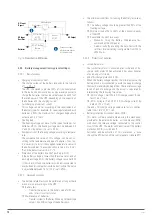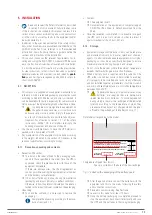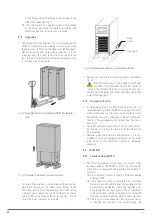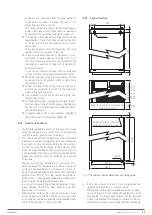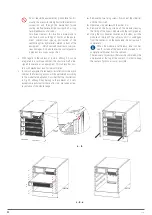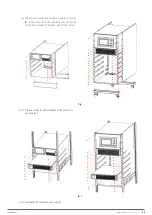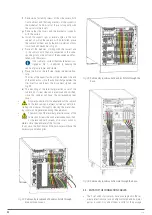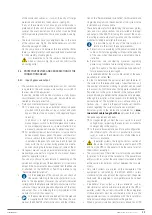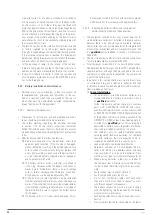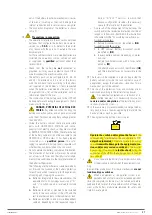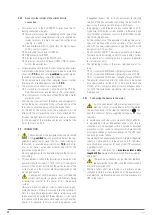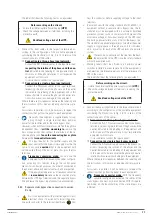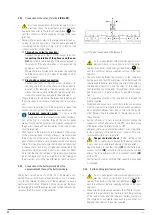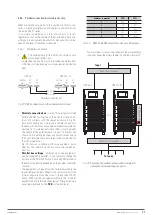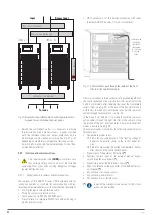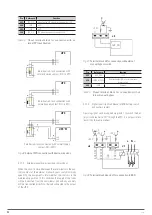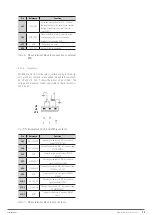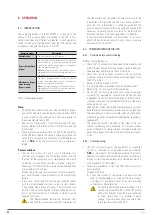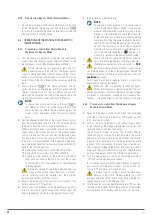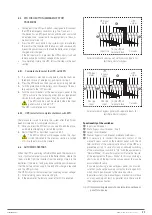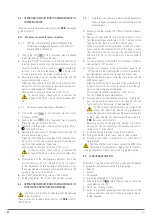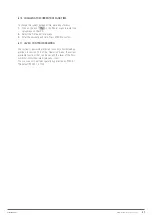
26
SALICRU
or parallel system as an option, as standard or installed on
its own account, either on the input line, on the bypass line,
on the output or in all of them, they must be fitted with
protection against indirect contacts (earth leakage breaker;
RCD) at the output of each transformer, since due to its own
isolation feature it will prevent the tripping of the protec-
tions placed in the primary winding of the transformer in
case of electric shock in the secondary winding (output of
the isolation transformer).
•
We remind you that all the isolation transformers installed
or factory supplied, have the output neutral grounded
through a bridge between the neutral terminal and ground.
If the isolated output neutral is required, this bridge must
be removed, taking the precautions indicated in the respec-
tive local and/or national low voltage regulations.
•
For the passage of cables to the interior of the subrack,
there are cable glands mounted on the metal structure, in
addition a blind plate mechanized at the user's discretion.
•
In case of installation in neutral IT mode, the switches and
circuit breakers protection must cut the NEUTRAL in addi-
tion to the three phases.
5.4.2. Battery installation and maintenance.
•
Batteries are a source of energy, so take into account all
recommendations, guidelines and indications in this sec-
tion and specially when they are owned by the user in
which they must be manipulated, installed, connected be-
tween them and with the equipment.
5.4.2.1. General recommendations.
•
Precautions for installation, use and maintenance of bat-
teries should be provided by the manufacturers.
•
The safety warnings regarding the batteries indicated
in section 1.2.3 of the safety instructions (document
EK266*08) include issues that must be taken into account
when handling or dealing with equipment that incorporates
them.
•
Additionally consider the following premises:
Before accepting and using the batteries, check their
apparent good condition. If the housing is damaged,
broken, deformed or spilling, if the battery terminals are
dirty, corroded or rusted, act accordingly or replace with
a new one according to each case. Otherwise, there is
a risk of reduced battery capacity, electric leakage or
even a potential fire hazard.
The battery contains sulfuric acid that is confined in
its housing. However, when the battery case cracks or
breaks due to ill-treatment, there is an acid spillage
with its fateful consequences. Therefore, when han-
dling batteries, use the appropriate safety PPE.
At the end of its useful life, there may be increased
internal resistance and/or erosions of positive/negative
plates. If this condition continues without replacement,
it can overheat resulting in deformations or spillage of
the electrolyte. Be sure to replace the battery before
this happens.
If a battery spills, or if it is physically damaged, it must
be replaced, stored in a sulfuric acid resistant container
and disposed of in accordance with applicable laws.
5.4.2.2. Installing the batteries. Preliminary considerations
before connecting them and their protections.
•
The equipment covered in this user manual does not in-
clude batteries as elements installed in the same subrack
because there is no physical space available. However
the installer can carry out the adaptation to integrate both
blocks into a rack cabinet, under his responsibility and if he
is a
qualified
person (defined in section 1.2 of document
EK266*08).
•
The most standard assemblies in rack cabinets made by our
firm are represented in document EL096*00.
•
For all purposes in section 5.5.4. it is described the connec-
tion between the battery pack and the UPS, treated both as
separate entities, although they may cohabit in the same
cabinet or not, and even share the cabinet, the sub rack and
a part of the battery pack.
•
In general in this section there are some minimum traces
to consider and respect in relation to batteries and their
installation, especially when adaptations and/or modifica-
tions are made on their own:
In your installation.
–
For extra safety, install the external batteries in a
closed cabinet or in a battery room accessible only
by
qualified
personnel.
Inside the battery cabinet there are accessible
parts with HAZARDOUS VOLTAGE and conse-
quently risk of electric shock, so they are classified
as RESTRICTED ACCESS AREAS. Therefore the key
of the battery cabinet will not be available to the
OPERATOR or USER, unless it has been properly in-
structed or is a
qualified
person. This cataloging is
applicable to battery rooms, regardless of whether
they can be installed in cabinets or on a rack.
–
The cabinet is only for sealed maintenance-free
valve-regulated lead-acid batteries. For refillable
lead-acid batteries, they are expected to be in-
stalled on an enabled rack in a specific room.
–
Lead acid battery carries chemical hazards.
–
Reserve a minimum of 1.5 cm between the bat-
teries and the tray immediately above, allowing
free circulation of air around the batteries. Trays
will be pull-out type to simplify maintenance tasks.
–
When placing batteries in the trays or shelves of
the cabinet or rack will always start at the bottom,
in order to keep the center of gravity as low as pos-
sible.
–
Avoid sudden impacts and/or vibrations.
–
Avoid cable bending less than 10 cm.
–
Do not cross the battery cables with each other,
they are a risk that can lead to connection errors
with the consequent consequences.
–
The battery connection must be firm and comply
with the tightening torque required by the battery
manufacturer's specifications.
–
Each battery terminal must be isolated after its con-
nection.
–
Do not subject the cables connected to the termi-




